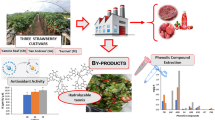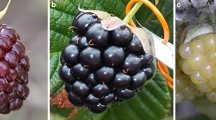Abstract
Strawberries represent the main source of ellagic acid derivatives in the Brazilian diet. They are also good sources of flavonoids, mainly anthocyanins, and phenolic acids, to which many beneficial effects have been attributed. However, as the fruit is not available all the year, the objective of this work was to determine whether the jams could also represent a good source of bioactive compounds. In the current study, five different commercially available strawberry jams were characterized in relation to flavonoids, total phenolics, free and total ellagic acid contents, and antioxidant capacity. Anthocyanins were detected only in two jams at very low content. Kaempferol glycosides were the main flavonoids present (from 0.38 to 1.05 mg/100 g fresh weight, FW), while quercetin glycosides were present in the range 0.14–1.20 mg/100 g FW. Free and total ellagic acid content ranged from 0.4 to 2.9 mg/100 g FW, and from 17.0 to 29.5 mg/100 g FW, respectively. Total phenolics varied from 58 to 136 mg/100 g FW, and the antioxidant capacity from 0.55 to 0.76 μmol BHT (Butylhydroxytoluene) equivalents/g FW. Overall, results indicated that jams can also represent a good source of antioxidant compounds, although compared to the fruit important losses seem to occur.
Similar content being viewed by others
References
Gil MI, Holcroft DM, Kader AA (1997) Changes in strawberry anthocyanins and other polyphenols in response to carbon dioxide treatments. J Agric Food Chem 45:1662–1667
Cordenunsi BR, Genovese MI, Nascimento JRO, Hassimotto NMA, Dos Santos RJ, Lajolo FM (2005) Effects of temperature on the chemical composition and antioxidant activity of three strawberry cultivars. Food Chem 91:113–121
Häkkinen SH, Kärenlampi SO, Mykkänen HM, Heinonen MI, Törrönen AR (2000) Ellagic acid content in berries: influence of domestic processing and storage. Eur Food Res Tech 212:75–80
Rommel A, Wrolstad RE (1993) Ellagic acid content of red raspberry juice as influenced by cultivar, processing, and environmental factors. J Agric Food Chem 41:1951–1960
Hannum SM (2004) Potential impact of strawberries on human health: a review of the science. Crit Rev Food Sci Nutr 44:1–17
Clifford MN, Scalbert A (2000) Ellagitannins-nature, occurrence and dietary burden. J Sci Food Agric 80:1118–1125
Wang H, Cao G, Prior RL (1996) Total antioxidant capacity of fruits. J Agric Food Chem 44:701–705
AOAC (1995) Official methods of analysis, 16th ed. Association of Official Analytical Chemists, Washington, DC
Arabbi PR, Genovese MI, Lajolo FM (2004) Flavonoids in vegetable foods commonly consumed in Brazil and estimated ingestion by the Brazilian population. J Agric Food Chem 52:1124–1131
Price KR, Prosser T, Richetin AMF, Rhodes MJC (1999) A comparison of the flavonol content and composition in dessert, cooking and cider-making apples; distribution within the fruit and effect of juicing. Food Chem 66:489–494
Zielinski H, Kozlowska H (2000) Antioxidant activity and total phenolics in selected cereal grains and their different morphological fractions. J Agric Food Chem 48:2008–2016
Marco GJ (1968) A rapid method for evaluation of antioxidants. J Am Oil Chem Soc 45:594–598
Hassimotto NMA, Genovese MI, Lajolo FM (2005) Antioxidant activity of dietary fruits, vegetables, and commercial frozen fruit pulps. J Agric Food Chem 53:2928–2935
Sato GS, Assumpçao R (2002) Instituto de Economia Agrícola do Governo do Estado de Sao Paulo—Pólos de produçao do morango. www.iea.sp.gov.br. Acessed: July, 2007
Häkkinen SH, Törrönen AR (2000) Content of flavonols and selected phenolic acids in strawberries and Vaccinium species: influence of cultivars, cultivation site and technique. Food Res Int 33:517–524
Häkkinen S, Heinonen M, Kärenlampi S, Mykkänen H, Ruuskanen J, Törrönen R (1999) Screening of selected flavonoids and phenolic acids in 19 berries. Food Res Int 32:345–353
Cordenunsi BR, Nascimento JRO, Genovese MI, Lajolo FM (2002) Influence of cultivar on quality parameters and chemical composition of strawberry fruits grown in Brazil. J Agric Food Chem 50:2581–2586
Arts ICW, Van de Putte B, Hollman CH (2000) Catechin contents of foods commonly consumed in the Netherlands. I. Fruits, vegetables, staple foods, and processed foods. J Agric Food Chem 48:1746–1751
Wang H, Cao G, Prior RL (1997) Oxygen radical absorbing capacity of anthocyanins. J Agric Food Chem 45:304–309
Wrolstad RE, Putman TP, Varseveld GW (1970) Color quality of frozen strawberries: effect of anthocyanin, pH, total acidity and ascorbic acid variability. J Food Sci 35:448–452
Rommel A, Heatherbell DA, Wrolstad RE (1990) Red raspberry juice and wine: effect of processing and storage on anthocyanin pigment composition, color and appearance. J Food Sci 55:1011–1017
Kim DO, Padilla-Zakour OI (2004) Jam processing effect on phenolics and antioxidant capacity in anthocyanin-rich fruits: cherry, plum and raspberry. J Food Sci 69:395–400
Clifford MN (2000) Anthocyanins—nature, occurrence and dietary burden. J Sci Food Agric 80:1063–1072
Vattem DA, Shetty K (2005) Biological functionality of ellagic acid: a review. J Food Biochem 29:234–266
Beattie J, Crozier A, Duthie GG (2005) Potential health benefits of berries. Curr Nutr Food Sci 1:71–86
Tomás-Barberán FA, Clifford MN (2000) Dietary hydroxybenzoic acid derivatives-nature, occurrence and dietary burden. J Sci Food Agric 80:1024–1032
Zafrilla P, Ferreres F, Tomás-Barberán FA (2001) Effect of processing and storage on the antioxidant ellagic acid derivatives and flavonoids of red raspberry (Rubus idaeus) jams. J Agric Food Chem 49:3651–3655
Pinto MS, Lajolo FM, Rivero M, Genovese MI (2005) Influence of cultivar on polyphenolics, vitamin C and antioxidant activity of strawberry fruits grown in Brazil. In: Fito P, Toldra F (eds) Intrafood—Innovations in traditional food, EFFoST Conference, Valencia, Spain, October, pp 915–918
Amakura Y, Umino Y, Tsuji S, Tonogai Y (2000) Influence of jam processing on the radical scavenging activity and phenolic content in berries. J Agric Food Chem 48:6292–6297
Klopotek Y, Otto K, Bohm V (2005) Processing strawberries of different products alters content of vitamin C, total phenolics, total anthocyanins, and antioxidant capacity. J Agric Food Chem 53:5640–5646
Acknowledgments
To FAPESP and CNPq for financial support. To the student Fernanda Marinho for the technical assistance.
Author information
Authors and Affiliations
Corresponding author
Rights and permissions
About this article
Cite this article
Da Silva Pinto, M., Lajolo, F.M. & Genovese, M.I. Bioactive Compounds and Antioxidant Capacity of Strawberry Jams. Plant Foods Hum Nutr 62, 127–131 (2007). https://doi.org/10.1007/s11130-007-0052-x
Received:
Accepted:
Published:
Issue Date:
DOI: https://doi.org/10.1007/s11130-007-0052-x




